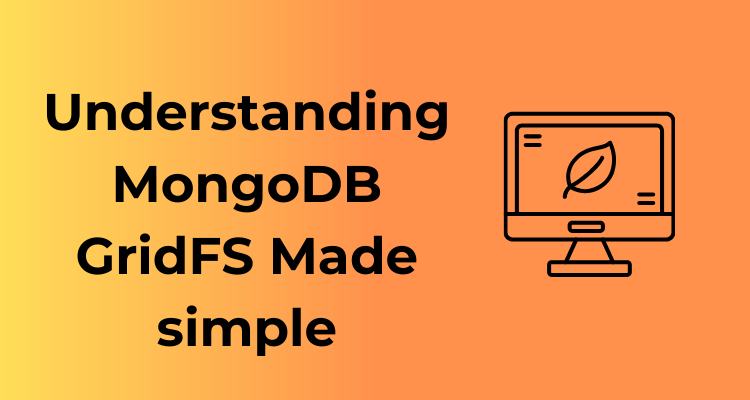Storing files in a database? It sounds simple enough, doesn’t it? Just slap your file into the database like you’d save a record, no big deal, right? Well, that’s not always the best approach. When it comes to handling large files, MongoDB’s GridFS comes to the rescue as a specialized solution. Let’s take a moment to chat about when you’d want to choose GridFS over just usual database storage or even your trusty file system.
Why Not Just Use Regular Storage for Files?
Regular storage in MongoDB is great — for typical, smaller pieces of data. But when it comes to hefty files, like high-resolution images, lengthy audio recordings, or 4K videos, regular storage can start to get clunky. MongoDB imposes a limit on the size of documents (16MBper document), and guess what? A full-length movie, a wedding album, or even some large PDFs can easily exceed that. That’s when you know it’s time to call in GridFS.
When Should You Consider Using GridFS?
Perfectly suited for handling large files, GridFS is ideal when:
- Your files exceed 16MB: Whether it’s video tutorials, large game assets, or industrial design files, GridFS splits those massive files into manageable chunks.
- You need metadata handling: Suppose each file is accompanied by lots of additional data — like who uploaded it, when it was last accessed, or tags for quick searching. GridFS pairs content and metadata beautifully.
- You want to leverage database querying: Let’s face it, managing files spread across a traditional file system can feel like juggling plates. With GridFS, you can query your files just as smoothly as any other MongoDB data — sweet, right?
- File integrity and retrievability are critical: If your application guarantees fault tolerance, GridFS stores file chunks as smaller, distributed pieces in the database. This makes retrieval safer and reduces the risk of single-point failure.
- Server environments restrict file systems: Think of cloud-based or containerized deployments, where accessing local disk storage isn’t so straightforward. GridFS can lend a huge helping hand here by moving files seamlessly into your MongoDB realm.
SQL COALESCE in Postgres: A Simple Guide: Read More
Examples of Real-World Use Cases
Still not sure where GridFS fits? Here are a few examples to make it click:
- Media streaming services: Store video and audio files while using metadata for search and organization.
- Data-heavy applications: Systems storing logs, research datasets, or machine-learning models.
- Content management systems: Need a backend for web apps storing photos, attachments, or documents? GridFS fits here perfectly.
- Backups: Database backups and versioned files benefit significantly from partitioning capabilities.
Breaking Down the Basics: How GridFS Stores Large Files
If you’ve ever wondered how MongoDB manages to efficiently handle large files that just can’t fit into a single document, you’re not alone! Enter GridFS, the go-to solution for storing and retrieving large files like images, videos, or any sizable data chunks. Let’s break it down to see how this clever system works behind the scenes to make your development life a breeze.
What is GridFS?
In simple terms, GridFS (Grid File System) is a specification that allows you to store large files in MongoDB. MongoDB documents have a size limit of 16MB. Anything larger than that won’t fit into a single document. That’s where GridFS steps in.
It works by breaking large files into smaller chunks (typically 255KB pieces by default) and storing them across multiple documents in two collections:
- fs.files: Contains metadata about the file, such as the filename, upload date, size, and other info like content type.
- fs.chunks: Stores the actual file content, split into bite-sized chunks, with each chunk assigned a unique identifier.
This ingenious approach allows you to efficiently handle files that exceed MongoDB’s document size limit while maintaining performance and organization.
Why Break Files Into Chunks?
It might sound counterintuitive, but splitting files into smaller parts makes things more efficient. Here’s why:
- Scalable Storage: By breaking files into chunks, you can store data across multiple documents, distributing the workload evenly within the database.
- Efficient Retrieval: Only the necessary chunks of a file are accessed when you query for file data, which means you’re not wasting time or resources pulling the whole file when it’s not needed.
- Fault Tolerance: If one chunk experiences an issue, it won’t render the entire file unusable, making your system more resilient.
How Does the Magic Happen?
Here’s a quick step-by-step breakdown of how GridFS handles a file:
- File Upload: When you upload a file, GridFS divides it into chunks of up to 255KB each. The size of these chunks can be customized if needed.
- Saving Metadata: As the file gets chunked, GridFS creates an entry in the
fs.filescollection to store metadata such as the file name, size, and timestamp. - Saving Chunks: Each chunk is stored as a separate document in the
fs.chunkscollection, tagged with a unique identifier and an index number that allows them to be reconstructed in the correct order. - Reassembly: When you retrieve the file, GridFS seamlessly pulls the chunks from the database and stitches them back together, delivering the original file just as you uploaded it.
When to Use GridFS
GridFS is not just for large files! You might also choose it for files that require metadata or files you frequently need to stream in parts. For example:
- Streaming video files to users without downloading the whole file upfront.
- Large image uploads that need metadata like resolution, format, or author info.
- Archiving massive logs or datasets.
Key Advantages of Choosing GridFS for Your Database
When it comes to managing larger-than-life files in your database, MongoDB’s GridFS can be a game-changer. Why? It’s not just another way to store data; it’s a smarter, scalable solution when the traditional methods start to feel clunky. Curious about what makes GridFS stand out? Let’s dive into its key advantages!
1. No File Size Limitations
One of the primary reasons developers fall in love with GridFS is its capacity to handle files of any size. Unlike the regular MongoDB document storage—which has a strict BSON document size limit of 16MB—GridFS splits hefty files into manageable chunks. How cool is that? Whether you’re dealing with images, videos, or gigantic PDFs, GridFS has your back.
2. Efficiency in Data Retrieval
The beauty of GridFS extends beyond just storage. It allows partial file retrieval too! Let’s say you’re managing a video hosting app and a user starts streaming halfway through a video. With GridFS, you don’t need to retrieve the entire file; you can fetch only the required chunks. This feature makes streaming and large file access incredibly efficient.
3. Built-in Scalability
If scaling your application is on your mind, GridFS offers an effortless way to handle it. Since MongoDB operates well with distributed systems, GridFS chunks can be automatically managed across multiple servers or shards. This ensures seamless horizontal scalability as your data grows, without compromising on speed or reliability.
4. Metadata Makes Organization Easy
A lesser-discussed yet fabulous feature of GridFS is its use of metadata. Each file stored in GridFS can include metadata that you define. This could be tags, descriptions, timestamps, or even information about who uploaded the file. This added layer of structure makes it simpler to locate and manage your files later.
5. Fault Tolerance
We can’t talk about large-scale data handling without addressing dependability. GridFS’s chunking model ensures that if one chunk of a file is corrupted or missing, the rest of the file remains safe. This fault-tolerance is a lifesaver for applications handling critical data like medical images or backups. It’s a layer of security you didn’t know you needed!
6. Flexibility in Use Cases
Whether you’re building a media-heavy application, a document management system, or even a cloud storage solution, GridFS shines across varied domains. By pairing GridFS with the indexing and querying power of MongoDB, you can develop applications capable of handling everything from archival data to real-time streaming.
Step-by-step Guide: Implementing GridFS in Your Application
So, you’ve decided to dive into the world of MongoDB’s GridFS—a robust solution for storing and retrieving large files in your database. Don’t worry; implementing GridFS in your application isn’t as daunting as it might sound. In fact, I’ll guide you through the process, step by step, ensuring that you feel confident when you roll up your sleeves and get started.
1. Make Sure You’re Ready
Before jumping into implementation, double-check a few things:
- Install MongoDB: Make sure MongoDB is installed and running on your system.
- Choose Your Programming Language: GridFS is language-agnostic and works with drivers for languages like Python, Node.js, Java, etc. Choose one you’re comfortable with.
- Understand GridFS’s Mechanics: Remember, GridFS splits files into smaller
chunksand stores them in two collections—fs.files(metadata) andfs.chunks(data). Familiarity with this structure helps as you move forward.
2. Get Your Driver Set Up
Each language has a MongoDB driver that simplifies interactions with the database. For instance:
-
- In Node.js, install the
mongodbpackage using npm:
- In Node.js, install the
npm install mongodb-
- For Python, use
pymongo:
- For Python, use
pip install pymongoMake sure the driver documentation is handy for quick references if you need help.
3. Initialize GridFS
With the MongoDB driver installed, the next step is to create a GridFS instance within your application. Most drivers provide a helper library or module for this. For example:
// Node.js example
const MongoClient = require('mongodb').MongoClient;
const GridFSBucket = require('mongodb').GridFSBucket;
MongoClient.connect("mongodb://localhost:27017/mydb", (err, client) => {
if (err) throw err;
const db = client.db("mydb");
const bucket = new GridFSBucket(db);
});
This snippet creates a connection to the GridFS instance within your application. Replace mydb with your database name.
4. Upload Files to GridFS
Uploading a file is straightforward. Using the Node.js example:
const fs = require('fs');
const uploadStream = bucket.openUploadStream("example-file.txt");
fs.createReadStream('./path/to/example-file.txt').pipe(uploadStream);
This code opens a file locally and streams it directly into GridFS. The filename example-file.txt becomes its identifier in the database’s fs.files collection.
5. Download or Retrieve Files
Once files are in GridFS, retrieving them is just as easy. Here’s how you might download the file we just uploaded:
const downloadStream = bucket.openDownloadStreamByName("example-file.txt");
downloadStream.pipe(fs.createWriteStream('./output-dir/example-file.txt'));
This code streams the file content from GridFS straight into a local directory.
6. Delete Files if Needed
Need to remove a file from GridFS? Use the file’s ID or name to securely delete it:
bucket.delete(FILE_ID, (err) => {
if (err) throw err;
console.log("File deleted.");
});
7. Test, Test, Test!
I can’t emphasize this enough—test your implementation thoroughly. Upload files of various sizes, download them, and observe how your application behaves. Doing so ensures your setup is bulletproof.
How to Query and Retrieve Data from GridFS Efficiently
Have you ever wondered how to effectively pull that huge video file or bundle of high-resolution images back from MongoDB’s GridFS? You’re not alone! Querying and retrieving data efficiently from GridFS can seem like a daunting task at first, but don’t worry – I’m here to guide you through it step by step.
Understanding GridFS Queries
Before we dive into querying, let’s refresh on what GridFS actually does. GridFS stores chunks of a file in a dedicated chunks collection and keeps metadata about the file (like filename, upload date, and content type) in a files collection. So, when you query GridFS, you’re really targeting the metadata stored in the files collection.
Basic Querying
If you want to retrieve a file, you need to locate it with a query on the files collection. A simple example might look like this:
db.fs.files.find({ filename: "example.mp4" })
This will pull up the metadata of the file you’re after. Once identified, the magic happens when the database compiles and reconstructs the chunks, giving you the complete file. Pretty neat, right?
Know Your Tools
There are a variety of tools at your disposal when working with GridFS. Let’s break them down:
- The MongoDB Drivers: Most official MongoDB drivers (e.g., for Node.js, Python, Java) come with built-in GridFS utilities. These simplify querying and retrieving GridFS files programmatically.
- GridFS Find: With
GridFSBucket.find(), you can pass queries to narrow down your search. This is especially useful when multiple files share similar names. - Metadata Queries: When uploading files to GridFS, assign custom metadata. Then, you can query based on these fields, something like:
db.fs.files.find({ "metadata.owner": "TeamA" })
Retrieving Files Dynamically
Let’s move beyond finding files and focus on retrieving and downloading them. When you query the files collection and get the desired file, you’ll pass its _id to retrieve the content. Here’s how it looks in Node.js:
const fs = require('fs');
const bucket = new mongodb.GridFSBucket(db);
bucket.openDownloadStreamByName("example.mp4").pipe(fs.createWriteStream('./example.mp4'));
The openDownloadStreamByName function ensures you get the complete file, while piping streams it directly to a local writable source.
Efficient Strategies
So, how can you be efficient about all this? Here are a few tips:
- Leverage File Indexing: Ensure you’ve indexed important fields like
filenameand custom metadata for lightning-fast queries. - Optimize Chunk Sizes: The default chunk size is 255 KB, but tweaking it based on your application needs can reduce overhead.
- Lazy Loading: Only retrieve files when absolutely needed. Don’t fetch data you’re not going to use!
- Batch Processing: For bulk file downloads, query and retrieve them in manageable groups rather than one massive operation.
Watch Out for Potential Pitfalls
While querying in GridFS is pretty straightforward, there are a couple of things to be mindful of:
- Large Payloads: Querying metadata for thousands of files at once can be resource-intensive. Try paginating results for better performance.
- Incomplete Chunks: If any chunks are corrupted or missing, the file won’t be retrieved correctly. Maintaining clean data is vital!
Best Practices to Optimize GridFS Performance
Alright, let’s talk about ensuring that your GridFS implementation is running like a well-oiled machine. Whether you’re managing large media files or documents, applying the right best practices can significantly enhance the performance and efficiency of GridFS in your application. Let’s dive into some tips and tricks that will help you get the most out of GridFS.
1. Plan Your Chunk Size Wisely
When it comes to GridFS, one of the first things to configure is the chunk size. By default, MongoDB splits files into 255 KB chunks. However, this might not be the ideal size for every project. If your files are larger and require frequent access, increasing the chunk size (e.g., 1 MB) can reduce the number of I/O operations and speed things up. Conversely, smaller files may benefit from smaller chunk sizes to avoid unnecessary overhead.
Pro Tip: Try different chunk sizes in a staging environment and benchmark performance based on your file access patterns. Adjust accordingly!
2. Use Proper Indexing
Indexes are your productivity heroes when working with any database, and GridFS is no exception. Always maintain indexes on the files and chunks collections. For example, creating indexes on { filename: 1, uploadDate: 1 } in the files collection can help speed up queries for retrieving specific files.
Additionally, indexing the { files_id: 1, n: 1 } field in the chunks collection ensures that GridFS can quickly locate the specific chunks it needs for file assembly.
3. Avoid Overloading GridFS with Too Many Small Files
While GridFS is fantastic for handling large files, it’s not optimized for storing massive numbers of tiny files. Why? Each file, regardless of its size, has associated metadata and indexing overhead. If you need to store many small objects like thumbnails or log files, consider sticking with a standard database collection or a storage solution designed for small files, like Amazon S3.
4. Optimize Network Traffic
If your application frequently downloads files from GridFS, make sure you’re compressing and caching the data wherever possible. Network bandwidth is often the limiting factor for performance, especially with larger files. By leveraging compression algorithms and HTTP caching headers, you can reduce latency and improve user experience.
Pro Tip: Use a content delivery network (CDN) in conjunction with GridFS for serving large files to end-users, reducing the load on your database.
5. Monitor and Profile Performance Regularly
The secret to optimization is continuous monitoring. Use MongoDB’s built-in tools like the profiler or third-party monitoring solutions to analyze how GridFS is performing. Look out for metrics such as read/write latencies, query execution times, and memory consumption. These insights will guide you in fine-tuning your GridFS setup.
6. Take Advantage of Sharding
If you’re dealing with enormous volumes of files and users, sharding your MongoDB database can help distribute the workload. This enables your GridFS to handle large datasets more effectively by spreading data across multiple nodes. Make sure to shard the files and chunks collections appropriately—usually by file ID or another unique identifier.
7. Clean Up Unused Files
Over time, your database can accumulate old or unused files, bloating storage and impacting performance. Implement a cleanup strategy to remove obsolete files regularly. For instance, you could use a script to delete files older than a set timeframe or archive them to a cheaper storage solution.
Pro Tip: Use the uploadDate field in the files collection to identify files for pruning.
8. Test Before Deploying to Production
Never skip stress-testing your GridFS setup in a non-production environment. It helps you uncover potential bottlenecks, compatibility issues, or unexpected behavior before users encounter them.
Common Mistakes to Avoid When Working with GridFS
Let’s face it: no one likes learning things the hard way, especially when it comes to handling storage in MongoDB using GridFS. While this technology offers some great features for managing and storing large files, there are some pitfalls that you might stumble into if you’re not careful. Don’t worry — I’ve got your back! In this guide, we’ll walk through some of the most common mistakes developers tend to make when working with GridFS, and more importantly, how to avoid them.

1. Not Splitting Files Properly
GridFS is designed to split large files into smaller chunks for efficient storage and retrieval. However, some developers attempt to upload gigantic files without understanding the proper chunk sizes. By default, GridFS uses a chunk size of 255 KB, but you can customize this setting to fit your needs.
What’s the fix? Always ensure you’re setting a chunk size that balances performance and storage requirements. If the chunks are too small, it could lead to inefficiencies during read/write operations. If they’re too large, smaller updates within a file might become cumbersome.
2. Ignoring Indexing for GridFS Collections
Indexing is a powerful way to enhance query performance in MongoDB, but many developers overlook this for GridFS collections (e.g., fs.files and fs.chunks). Without proper indexing, retrieving files – especially when your database grows – can become a painfully slow process.
Pro Tip: By default, GridFS indexes the filename and uploadDate. If you’re frequently querying by other parameters like metadata, add the necessary indexes to speed up searches and reduce query time.
3. Assuming GridFS Is the Right Tool for Every Large File
GridFS excels when you’re dealing with files larger than MongoDB’s BSON-document size limit of 16 MB. But here’s the catch: it’s not always the best choice for every large file! If you’re storing files that don’t exceed that size limit or don’t require streaming, sticking to standard binary storage or using an external file storage system (like AWS S3) can sometimes be simpler and more efficient.
Lesson Learned: Don’t default to GridFS out of habit! Assess your use case and file storage requirements. Sometimes simplicity is key.
4. Neglecting Metadata Organization
When working with GridFS, metadata is your best friend, helping you organize your files and enabling more efficient data retrieval. However, a common mistake is overlooking this key component altogether. Without meaningful metadata, you may struggle to locate specific files later.
What to do: Always add relevant, structured metadata (e.g., category, file type, or processing status) to the fs.files collection. It’s going to make your life so much easier when querying or categorizing large datasets.
5. Failing to Implement File Backup and Replication
“It’ll never happen to me,” famous last words, right? While GridFS does inherit MongoDB’s replication and backup capabilities, some developers fail to account for proper backups and disaster recovery processes.
The Solution: Leverage MongoDB replica sets and ensure your fs.chunks and fs.files collections are included in your backup routine. Test your restoration process regularly to ensure your setup works when it’s really needed!
6. Mismanaging Expired or Unused Files
Storing unnecessary files for too long in GridFS can lead to bloated databases, increased storage costs, and slower queries over time. Sadly, some developers don’t implement proper cleanup processes.
How to avoid this: Add a mechanism to periodically delete unused or expired files based on your requirements. For instance, if files are tagged with a timestamp in their metadata, you could use a scheduled job to remove old files efficiently.










